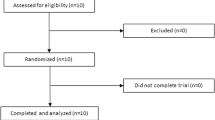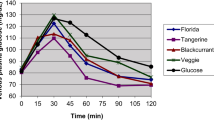Abstract
Objectives
This study compared the effects of consuming different forms (bite size, puree) and two fruit types (guava, papaya) on glycemic response (GR) in elderly and young adults.
Design
This study was conducted using a randomized, crossover design.
Participants
Nineteen healthy participants (9 elderly, 10 young adults) were recruited from the general public in Singapore. Intervention: Participants consumed glucose (reference food) on three occasions and test fruits (guava bites, guava puree, papaya bites, and papaya puree) on one occasion each.
Measurements
Blood glucose was analyzed prior to consuming the test food, at 15, 30, 45, 60, 90 and 120 minutes after food consumption.
Results
The incremental area under the blood glucose response curve (iAUC) over 120 minutes for all the treatments was significantly lower than glucose (all P < 0.001). All fruit forms and types studied were low glycemic index (GI) (guava bites: 29; papaya bites: 38; papaya puree: 42; guava puree: 47), albeit a significant difference in GI between the treatments was found (P = 0.003). Elderly exhibited significantly greater GR than young participants (P = 0.019).
Conclusion
Although fruit form influences GR in the elderly and young adults, all fruit types and forms studied were found to be low GI. This study indicates that fruits are a valuable source of nutrient irrespective of the form of delivery in elderly and young adults. This study was registered at www.anzctr.org.au as ACTRN12614000655640.


Similar content being viewed by others
Abbreviations
- CV:
-
coefficient of variation
- GI:
-
glycemic index
- GR:
-
glycemic response
- iAUC:
-
incremental area under the curve
- VAS:
-
visual analog scale
References
Henry CJ. Mechanisms of changes in basal metabolism during ageing. Eur J Clin Nutr 2000;54 Suppl 3:S77–91.
John BK, Bullock M, Brenner L, McGaw C, Scolapio JS. Nutrition in the elderly. Frequently asked questions. Am J Gastroenterol 2013;108:1252–1266.
Milan AM, Cameron-Smith D. Digestion and postprandial metabolism in the elderly. In: Henry J (ed). Advances in Food and Nutrition Research. Academic Press, San Diego, 2015;pp 79–124.
Russ DW, Nakazawa M, Boyd IM. A pilot study of age-related changes in the sphingolipid composition of the rat sarcoplasmic reticulum. J Frailty Aging 2015;4:166–172.
Juanola-Falgarona M, Salas-Salvadó J, Buil-Cosiales P, Corella D, Estruch R, Ros E, Fitó M, et al. Dietary glycemic index and glycemic load are positively associated with risk of developing metabolic syndrome in middle-aged and elderly adults. J Am Geriatr Soc 2015;63:1991–2000.
Oya J, Nakagami T, Yamamoto Y, Fukushima S, Takeda M, Endo Y, Uchigata Y. Effects of age on insulin resistance and secretion in subjects without diabetes. Intern Med 2014;53:941–947.
Thomas GN, Hong AWL, Tomlinson B, Lam CWK, Critchley JAJH, Sanderson JE, Woo J, et al Increasing insulin resistance contributes to worsening glycaemic and lipid profiles in older Chinese subjects. Diabetes Res Clin Pract 2004;64:123–128.
Toyoda K, Fukushima M, Mitsui R, Harada N, Suzuki H, Takeda T, Taniguchi A, et al. Factors responsible for age-related elevation in fasting plasma glucose: a crosssectional study in Japanese men. Metabolism 2008;57:299–303.
Tyrovolas S, Haro JM, Mariolis A, Piscopo S, Valacchi G, Makri K, Zeimbekis A, et al. The role of energy balance in successful aging among elderly individuals: The Multinational MEDIS Study. J Aging Health 2015;27:1375–1391.
Christensen AS, Viggers L, Gregersen S. Fruit and glycemic control in type 2 diabetes. In: Watson RR and Dokken BB (ed). Glucose intake and utilization in prediabetes and diabetes. Academic Press, Boston, 2015;pp 215–223.
Diep CS, Baranowski J, Baranowski T. The impact of fruit and vegetable intake on weight management. In: Gill T (ed). Managing and preventing obesity. Woodhead Publishing, Cambridge, 2015;pp 59–78.
Isabelle M, Lee BL, Lim MT, Koh W-P, Huang D, Ong CN. Antioxidant activity and profiles of common fruits in Singapore. Food Chem 2010;123:77–84.
International Agency for Research on Cancer. IARC handbooks of cancer prevention. Fruit and vegetables. IARC Press, Lyon, 2003.
Woodside JV, Young IS, McKinley MC. Fruits and vegetables: measuring intake and encouraging increased consumption. Proc Nutr Soc 2013;72:236–245.
World Health Organization and Food and Agricultural Organization. Diet, nutrition and the prevention of chronic diseases. World Health Organization, Geneva, 2003.
Chen Y-Y, Wu P-C, Weng S-F, Liu J-F. Glycemia and peak incremental indices of six popular fruits in Taiwan: healthy and Type 2 diabetes subjects compared. J Clin Biochem Nutr 2011;9:195–199.
Christensen A, Viggers L, Hasselström K, Gregersen S. Effect of fruit restriction on glycemic control in patients with type 2 diabetes–a randomized trial. Nutr J 2013;12:1–6.
Hegde SV, Adhikari P M N, D’Souza V. Effect of daily supplementation of fruits on oxidative stress indices and glycaemic status in type 2 diabetes mellitus. Complement Ther Clin Pract 2013;19:97–100.
Slavin JL, Lloyd B. Health benefits of fruits and vegetables. Adv Nutr 2012;3:506–516.
Atkinson FS, Foster-Powell K, Brand-Miller JC. International tables of glycemic index and glycemic load values: 2008. Diabetes Care 2008;31:2281–2283.
Lee BM, Wolever TM. Effect of glucose, sucrose and fructose on plasma glucose and insulin responses in normal humans: comparison with white bread. Eur J Clin Nutr 1998;52:924–928.
Muraki I, Imamura F, Manson JE, Hu FB, Willett WC, van Dam RM, Sun Q. Fruit consumption and risk of type 2 diabetes: results from three prospective longitudinal cohort studies. BMJ 2013;347:f5001.
Bazzano LA, Li TY, Joshipura KJ, Hu FB. Intake of fruit, vegetables, and fruit juices and risk of diabetes in women. Diabetes Care 2008;31:1311–1317.
Odegaard AO, Koh W-P, Arakawa K, Yu MC, Pereira MA. Soft drink and juice consumption and risk of physician-diagnosed incident type 2 diabetes: the Singapore Chinese Health Study. Am J Epidemiol 2010;171:701–708.
Sartorelli DS, Franco LJ, Gimeno SGA, Ferreira SRG, Cardoso MA. Dietary fructose, fruits, fruit juices and glucose tolerance status in Japanese–Brazilians. Nutr Metab Cardiovasc Dis 2009;19:77–83.
Nicklett EJ, Kadell AR. Fruit and vegetable intake among older adults: A scoping review. Maturitas 2013;75:305–312.
Zhu Y, Hollis JH. Differences in chewing behaviors between healthy fully dentate young and older adults assessed by electromyographic recordings. Int J Food Sci Nutr 2015;66:452–457.
de Graaf C. Texture and satiation: the role of oro-sensory exposure time. Physiol Behav 2012;107:496–501.
Laguna L, Sarkar A, Artigas G, Chen J. A quantitative assessment of the eating capability in the elderly individuals. Physiol Behav 2015;147:274–281.
Walls AWG, Steele JG. The relationship between oral health and nutrition in older people. Mech Ageing Dev 2004;125:853–857.
International Standards Organisation. ISO 26642-2010: Food products -determination of the glycaemic index (GI) and recommendation for food classification. International Standards Organisation, Switzerland, 2010.
Brouns F, Bjorck I, Frayn K, Gibbs A, Lang V, Slama G, Wolever T. Glycaemic index methodology. Nutr Res Rev 2005;18:145–171.
FAO/WHO. Carbohydrates in human nutrition -Report of a joint FAO/WHO expert consultation. Food and Agriculture Organisation, Rome, 1998.
Bolton RP, Heaton KW, Burroughs LF. The role of dietary fiber in satiety, glucose, and insulin: studies with fruit and fruit juice. Am J Clin Nutr 1981;34:211–217.
Ranawana V, Leow MK-S, Henry CJK. Mastication effects on the glycemic index: impact on variability and practical implications. Eur J Clin Nutr 2014;68:137–139.
Foster-Powell K, Holt SH, Brand-Miller JC. International table of glycemic index and glycemic load values, 2002. Am J Clin Nutr 2002;76:5–56.
Guevarra MTB, Panlasigui LN. Blood glucose responses of diabetes mellitus type II patients to some local fruits. Asia Pac J Clin Nutr 2000;9:303–308.
Yusof BNM, Talib RA, Karim NA. A study of blood glucose response following temperate and tropical fruit ingestion in healthy adults. Malay J Nutr 2005;11:47–57.
Devalaraja S, Jain S, Yadav H. Exotic fruits as therapeutic complements for diabetes, obesity and metabolic syndrome. Food Res Int 2011;44:1856–1865.
Jenkins DJ, Srichaikul K, Kendall CW, Sievenpiper JL, Abdulnour S, Mirrahimi A, Meneses C, et al. The relation of low glycaemic index fruit consumption to glycaemic control and risk factors for coronary heart disease in type 2 diabetes. Diabetologia 2011;54:271–279.
Tsubota-Utsugi M, Kikuya M, Satoh M, Inoue R, Hosaka M, Metoki H, Hirose T, et al. Living situations associated with poor dietary intake among healthy japanese elderly: the Ohasama study. J Nutr Health Aging 2015;19:375–382.
Author information
Authors and Affiliations
Corresponding author
Rights and permissions
About this article
Cite this article
Tey, S.L., Lee, D.E.M. & Henry, C.J. Fruit form influences postprandial glycemic response in elderly and young adults. J Nutr Health Aging 21, 887–891 (2017). https://doi.org/10.1007/s12603-017-0880-9
Received:
Accepted:
Published:
Issue Date:
DOI: https://doi.org/10.1007/s12603-017-0880-9




